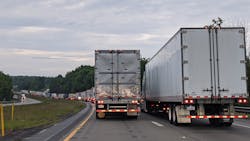The Biden administration is "pressing the accelerator" to reach a zero-emission future “sooner than most people thought” with a plan to further reduce emissions from trucks and buses during the transition to electric powertrains, federal officials announced Monday.
The proposed action would reduce NOx emissions from trucks by as much as 60% in 2045.
Various trucking industry interests were cautiously hopeful, pending the development of a final regulation, that the plan would become “the next step” in the ongoing evolution of highway freight transportation.
Specifically, the U.S. Environmental Protection Agency (EPA) is proposing new, stronger standards for heavy-duty vehicles and engines starting in model year 2027. The standards would reduce emissions of nitrogen oxides (NOx) and set updated greenhouse gas (GHG) standards for certain commercial vehicle categories.
Trucking industry groups responded with cautious optimism about the proposal, noting that fleets, OEMs, engine-makers, and other transportation stakeholders have been working for years to reduce NOx emissions and make heavy-duty trucks more fuel-efficient. A larger concern among trucking is the cost of zero-emission equipment and the lack of infrastructure to support non-diesel long-haul operations.
“Seventy-two million people are estimated to live near truck freight routes in America, and they are more likely to be people of color and those with lower incomes. These overburdened communities are directly exposed to pollution that causes respiratory and cardiovascular problems, among other serious and costly health effects,” EPA Administrator Michael S. Regan said. “These new standards will drastically cut dangerous pollution by harnessing recent advancements in vehicle technologies from across the trucking industry as it advances toward a zero-emissions transportation future.”
The benefits of the proposed rule would exceed its costs by billions of dollars, EPA said. The administration estimates that the most ambitious option outlined in these standards would result in 18,000 fewer cases of childhood asthma, 1.1 million fewer lost school days for kids, and 6,700 fewer hospital admissions and ER visits.
The action is the first step in EPA’s “Clean Trucks Plan”—a series of clean air and climate regulations that the agency will develop over the next three years to reduce pollution from trucks and buses.
Planning a route to zero-emissions
EPA’s goal is to deliver significant and needed public health benefits by designing a program that sets ambitious standards and that are feasible for the trucking industry after giving appropriate consideration to cost and other factors while supporting the American economy. To accomplish this, EPA has identified several options in the proposal that address the robustness of the standards, timing for phasing in the standards, options to incentivize early clean technology adoption, and improvements to emissions warranties.
The proposed revisions to existing GHG standards for model year 2027 and beyond would set updated GHG emissions standards for subsectors where electrification is advancing at a more rapid pace. These sectors include school buses, transit buses, commercial delivery trucks, and short-haul tractors.
In a separate action, EPA will be setting new GHG emissions standards for heavy-duty vehicles as soon as model year 2030. This action will more comprehensively address the long-term trend toward zero-emission vehicles across the heavy-duty sector, according to the agency.
Also speaking at the announcement, Vice President Kamala Harris recalled when, as California attorney general, she visited the community of Mira Loma, which has “had some of the worst air pollution in the state.”
“In Mira Loma, every day, heavy-duty trucks made more than 15,000 trips to that town’s main roads, bringing with them, of course, soot and exhaust. And the air turned toxic,” Harris said. “The first time I went to Mira Loma, you could taste the metal in the air. My eyes burned. The toxicity in the air was that thick.”
The new truck proposal, along with multibillion-dollar federal programs to support the transition of public transit and school bus fleets to electric vehicles, will be especially beneficial to “communities that have been left out and left behind” and suffered disproportionately from their proximity to major transportation hubs and routes, she explained.
“We can clean our air and protect the health of our children. We can connect all of our communities with affordable, accessible, and reliable public transportation. We can address the climate crisis and grow our economy at the same time,” Harris said. “And I am here today to say: Together, we all are doing just that. With the help of the American people, we are building a better future for all who call our dear country home.”
Trucking industry reacts to EPA proposal
In a statement, American Trucking Associations President and CEO Chris Spear said the association and industry would be “closely reviewing" the Biden administration’s proposed emissions rules for heavy-duty trucks, but it will be critical that these rules result in “usable, reliable, and cost-effective equipment.”
“We share the Biden administration’s goals of reducing air pollution—as a longtime member of EPA SmartWay Transport Partnership—we have worked in harmony with environmental regulators to successfully reduce greenhouse gas and NOx emissions,” Spear said. “We want to ensure that the Biden administration sets one, single national NOx emissions standard and that such standard can be achieved with workable, reliable technology. Anything less than that will be extremely problematic for ATA and our members.”
Similarly, the Diesel Technology Forum, an organization formed to support and improve diesel engines in a wide variety of applications and industries, noted that truck and engine manufacturers and their customers have already worked for two decades to “virtually eliminate emissions” from heavy-duty highway vehicles and that new EPA proposal to establish future standards is the “next stop on that journey.”
Indeed, as a result of current policies, new diesel trucks are more efficient and are 98% lower in emissions compared to the previous generation (pre-2010) and since 2006 have utilized ultra-low-sulfur diesel fuel (less than 15 ppm sulfur), DTF noted. Nearly half of all commercial trucks in operation today are of this newest generation.
“These advancements have contributed substantially to making our air cleaner and reducing greenhouse gas emissions,” DTF Executive Director Allen Schaeffer said, noting the resulting fuel savings and reduced emissions. “For this proposed rule, it is vitally important that EPA get this right. Diesel engines are going to continue to dominate many segments of the trucking sector for some time yet, even as alternative fuels and zero-emission vehicles become more available.
“The right rule will enable further improvements in diesel technology and continued investments in new vehicles that will be important to sustain progress toward meeting both clean air and climate goals.”
Schaeffer cautioned, however, that a rule that results in dramatic shifts in the new truck market—such as previous “pre-buys” ahead of major changes in engine designs to meet new standards—will be “bad for jobs, the economy, and the environment.” Similarly, “truckers must be willing and able to invest” in the next generation of advanced diesel products. Otherwise, older generations of technology with relatively higher emissions will stay in service longer, “thereby delaying benefits to disadvantaged communities and contributing to worse air quality all around the country.”
Likewise, the Truck and Engine Manufacturers Association (EMA) pointed out that heavy-duty truck and engine manufacturers have long advocated for and benefited from national standards for NOx emissions, and the association welcomed the proposed rule.
“We are firmly committed to continued NOx reductions because we support cleaner air and better health for all communities. We look forward to working with EPA to ensure that the final version of today’s rule is practical, technically feasible, cost-effective, and will result in the necessary fleet turnover to achieve the nation’s environmental objectives,” EMA President Jed Mandel said. “Engines made after 2010 emit roughly 30 times less NOx than those made before 2010. Yet only about 50% of the fleet has turned over and realized the benefits of that modern technology. It is imperative the new rule facilitate the transition to newer, cleaner trucks so we can achieve lower NOx emissions as soon as possible.”
EMA’s fact sheet about EPA’s proposed new rule to reduce NOx emissions is available here.
Indeed, EPA emphasized that the proposal reflects input from stakeholders, including community groups; manufacturers; and state, local, and tribal governments. The agency said it looks forward to hearing from all stakeholders involved in the rulemaking.
More information on the rule and the public comment process is available here.


